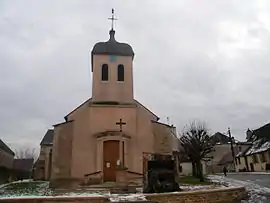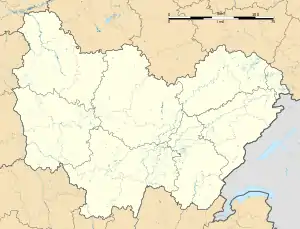Chorey-les-Beaune | |
|---|---|
 The church in Chorey-les-Beaune | |
.svg.png.webp) Coat of arms | |
Location of Chorey-les-Beaune | |
 Chorey-les-Beaune  Chorey-les-Beaune | |
| Coordinates: 47°02′53″N 4°52′06″E / 47.048°N 4.8683°E | |
| Country | France |
| Region | Bourgogne-Franche-Comté |
| Department | Côte-d'Or |
| Arrondissement | Beaune |
| Canton | Ladoix-Serrigny |
| Intercommunality | CA Beaune Côte et Sud |
| Government | |
| • Mayor (2020–2026) | Arnauld Guichard[1] |
| Area 1 | 5.59 km2 (2.16 sq mi) |
| Population | 610 |
| • Density | 110/km2 (280/sq mi) |
| Time zone | UTC+01:00 (CET) |
| • Summer (DST) | UTC+02:00 (CEST) |
| INSEE/Postal code | 21173 /21200 |
| Elevation | 199–245 m (653–804 ft) (avg. 217 m or 712 ft) |
| 1 French Land Register data, which excludes lakes, ponds, glaciers > 1 km2 (0.386 sq mi or 247 acres) and river estuaries. | |
Chorey-les-Beaune (French pronunciation: [ʃɔʁɛ le bɔn], literally Chorey near Beaune) is a commune in the Côte-d'Or department in eastern France.
It lies northeast of the city of Beaune on the plain of the Saône just to the east of the A31 autoroute.
Population
| Year | Pop. | ±% |
|---|---|---|
| 1962 | 372 | — |
| 1968 | 422 | +13.4% |
| 1975 | 484 | +14.7% |
| 1982 | 503 | +3.9% |
| 1990 | 508 | +1.0% |
| 1999 | 516 | +1.6% |
| 2008 | 480 | −7.0% |
Wine
Chorey-les-Beaune is one of the wine communes of the Côte de Beaune. The wines of Chorey-les-Beaune grow on the relatively flat land of the Saône plain, rather than on the slopes of the Côte d'Or, and for this reason the commune has no Premier Cru (or Grand Cru) vineyards. The soils are composed mostly of quaternary detrital and alluvial fills, and the wines tend to be thinner and less complex than those grown on the Jurassic limestone, gravels, and marls of the slopes from which the better quality wines of the Côte d'Or come.[3]
See also
References
- ↑ "Répertoire national des élus: les maires" (in French). data.gouv.fr, Plateforme ouverte des données publiques françaises. 13 September 2022.
- ↑ "Populations légales 2021". The National Institute of Statistics and Economic Studies. 28 December 2023.
- ↑ Fanet, Jacuqes Great Wine Terroirs, University of California Press, Berkeley (2004) pp. 39-42.